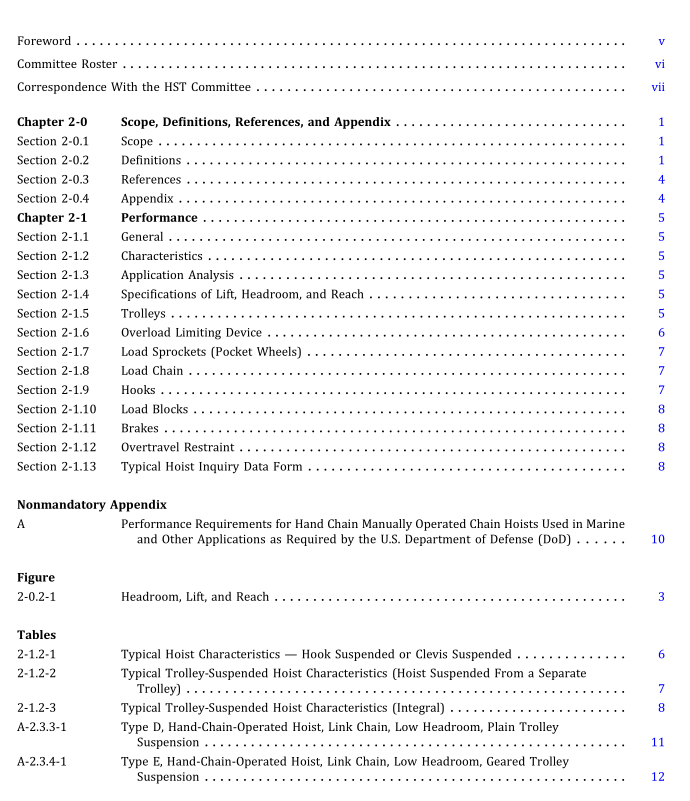ASME HST-2 pdf download

ASME HST-2 pdf download Performance Standard for Hand Chain Manually Operated Chain Hoists
SECTION 2-0.1:sCoPE
(a) This Standard establishes performance requirements for hand chain manually operated chain hoists for verticallifting service involving material handling of freely suspended(unguided) loads, using welded link type load chain as alifting medium, with one of the following types of suspension:
(1) hook or clevis
(2) trolley
(bj) This Standard is applicable to hoists manufactured after the date on which this Standard is issued. Differentialpulley and self-locking worm drive type hoists are not covered in this Standard.
(c) This Standard is not applicable to
(1) damaged or malfunctioning hoists
(2) hoists that have been misused or abused
(3) hoists that have been altered without authorization of the manufacturer or a qualified person(4) hoists used for lifting or supporting people
(5)hoists used for the purpose of drawing both the load and the hoist up or down the hoist’s own load chain(6) hoists used in applications where the load on the hand chain hoist is not freely suspended from the hand chainhoist
The requirements of this Standard shall be applied together with the requirements of ASMEB30.16.Please also refer toASME B30.16 for requirements pertaining to marking, construction, installation, inspection, testing, maintenance, andoperation.
SECTION 2-0.2: DEFINITIONS
ambient temperature: the temperature of the atmosphere surrounding the hoist.
beam: an overhead standard structural shape or specially fabricated shape on which a trolley operates.
chain, hand: the chain provided to control movement of a hand-chain-operated hoist or trolley (see Figure 2-0.2-1).NOTE:Hand chain and load chain properties do not conform to those shown in ASME B30.9.
chain, load: the load-bearing chain in the hoist.
NOTE: Hand chain and load chain properties do not conform to those shown in ASME B30.9.
conditions, abnormal operating: environmental conditions that are unfavorable, harmful, or detrimental to or for theoperation of a hoist, such as excessively high or low ambient temperatures,exposure to weather, corrosive fumes, dust.laden or moisture-laden atmospheres, and hazardous locations.
conditions, normal operating: conditions during which a hoist is performing functions within the scope of the originaldesign.
hand chain drop: the distance to the lowest point of the hand chain measured from the saddle of the load hook at its upperlimit of travel (see Figure 2-0.2-1).
hand chain overhaul: the number of feet (meters) the hand chain must travel to raise the load hook 1 ft (1 m).hand chain pull: the average force measured in pounds (kilonewtons) exerted by the operator on the hoist hand chain tolift the rated load.
hand chain wheel: a wheel with formed pockets on its periphery to allow torque to be transmitted when a force is appliedto the hand chain.
hazardous (classified) locations: locations where fire or explosion hazards may exist. Locations are classified depending on the properties of the flammable vapors, liquids, or gases, or combustible dust or fibers that may be present, and the likelihood that a flammable or combustible concentration or quantity is present. Refer to NFPA 70.
headroom: headroom is measured with the load hook at its upper limit of travel, and is the distance from the saddle of the load hook to the following (see Figure 2-0.2-1):
[a) saddle of the top hook on hook- suspended hoists
[b) saddle of clevis on clevis-suspended hoists
[c) wheel treadline on trolley-suspended hoists .
hoist, hand-chain-operated: a suspended machinery unit that, by use of manual operation, is used for lifting or lowering a freely suspended (unguided) load.
[a) hoist, clevis-suspended: a hoist suspended by means of a clevis or eye at the top of the hoist (see Figure 2-0.2-1).
(b) hoist, hook-suspended: suspension of a hoist from a trolley or rigid structure by means of a hook at the top of the hoist (see Figure 2-0.2-1).
[c} hoist, trolly-suspended: a hoist suspended from a trolley. A hoist can be connected to a trolley by hook or clevis, or the hoist can be integral with the trolley (see Figure 2-0.2-1).
hook latch: a mechanical device to close (bridge) the throat opening of a hook; a rigging aid not intended to support the load.
lift: the maximum vertical distance through which the load hook can travel, and is the total allowable hook movement between its upper limit of travel and its lower limit of travel (see Figure 2-0.2-1).
lifting devices, below-the-hook: devices that are not normally reeved onto the hoist chains, such as hook-on buckets,magnets, grabs, and other supplemental devices used for hanging or attaching to the load. The weight of these devices is to be considered part of the load to be lifted.









